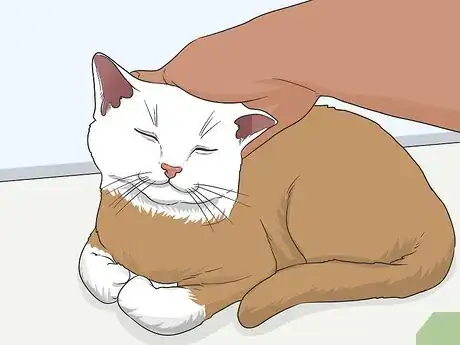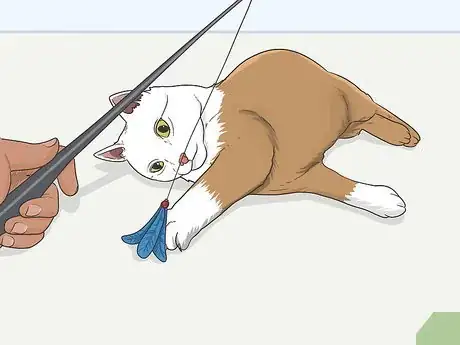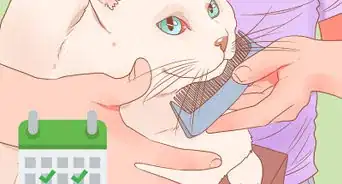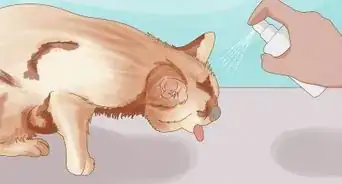This article was co-authored by Jessica Char. Jessica Char is a Cat and Dog Trainer, Behavior Consultant, and the Founder of Feline Engineering and Canine Engineering. She specializes in modifying challenging pet behavior problems, such as fear and aggression, using positive reinforcement training protocols. Jessica is a Certified Fear Free Trainer, a Certified Professional Dog Trainer, and a Certified Separation Anxiety Trainer. She is also a member of the International Association of Animal Behavior Consultants. Jessica received her BS and MS in Biomedical Engineering from Washington University in St. Louis.
There are 7 references cited in this article, which can be found at the bottom of the page.
wikiHow marks an article as reader-approved once it receives enough positive feedback. This article has 12 testimonials from our readers, earning it our reader-approved status.
This article has been viewed 387,203 times.
Do you find yourself wishing that your new cat would be more friendly and trusting of you? By nature, cats are more independent and don't depend on your friendship. They also take longer to trust and respond less quickly to bribery, like treats. Let your cat set the pace for befriending you and simply focus on making your cat feel safe and secure. Once they feel nurtured by their environment, they'll learn to trust you.
Steps
Creating a Nurturing Environment
-
1Allocate room and places for your cat. A good way to make your cat comfortable is to give the cat their own space.[1] A comfortable, warm place to sleep, eat, play and excrete/urinate. Another point is to look in pet stores and maybe even ask staff about cat shelves. These can be nailed to a wall in whatever position suits you and your cat so they have somewhere to look over the room and feel safe up there.
-
2Offer space for safety and exploration. There will be times when your cat feels insecure, scared, or anxious. Give them plenty of hiding places to go to when feeling frightened, like a closet or spot under the bed. It's fine to know where their hiding place is, but don't force your cat out of it unless you absolutely have to. You should also make sure your cat can access high perches (like window ledges, furniture, or a high cat scratch platform) and toys for when they're bored and want to look around or play.
- Immediately creating a safe and secure place is important. If you're trying to gain the trust of a new cat, keep them in one room so they can get familiar with their territory without feeling overwhelmed.[2]
- You should also take care to set the litter box in a private corner of the room. It should be away from anything noisy, like a dryer) and she should feel protected when she uses it (the 2 walls will offer this protection if it's in a corner).
Advertisement -
3Give food and water. Feed your cat on a regular basis so she understands that you provide food and shelter. When you set the food down, talk in a soft sing-song voice so she starts recognizing your voice and associating it with something positive, like mealtime. When your cat comes over to eat, back up and give her plenty of space. If you'd like to keep her company, sit down on the floor so you aren't towering over her, which could intimidate her.
- Make sure your cat can easily get to the food and water dishes. If she's shy, set them within reach of her hiding place, so she doesn't feel too traumatized or stressed by going out to get them.
-
4Help your cat to relax. Your cat may have trouble relaxing or feeling calm in a new environment. You can purchase a synthetic cat pheromone product (like Feliway) to diffuse in the room. This is a synthetic version of the chemical messengers a mother cat gives off to make her kittens feel safe and secure. The pheromone can reduce overall stress and can help the new cat settle in faster.[3]
- You might also consider getting your cat used to your scent as something familiar. This will help her recognize you when you start to make physical contact. For example, you might try letting your cat sleep with one of your old T-shirts that has your scent on it.[4]
-
5Offer positive reinforcement. A cat might be frightened of its new surroundings, regardless of how cozy you've made it. This is especially true if the cat was abused or neglected. Never yell at the cat when you notice her doing something she shouldn't. Chances are, she's just exploring her new environment. Instead, use a calm soothing voice to praise her for any good behavior she shows.[5]
- If your cat still seems frightened of her new surroundings, make sure that you're not scaring her. Never sneak up on your cat or make sudden movements that may catch her off guard. Cats that have been abused are more likely to be skittish, when you surprise them.
Encouraging Contact
-
1Watch for signs that your cat is ready for contact. Always let your cat come to you, rather than approach her. If you clearly see that your cat appears tense and is watching you intently (standing, tail stiff, pupils dilated), do nothing. Sit very still, preferably with your eyes closed. You'll be less of a threat this way and the cat will get used to your presence. On the other hand, if your cat is ready for contact, she may:[6]
- Stay in your sight after she finishes eating, instead of running for cover
- Take a few steps towards you
- Sit near you and wash (which shows she's relaxed)
- Sit with her back to you (which shows she trusts you)
-
2Appear less threatening. There are several ways you can appear less intimidating and make your cat feel more comfortable. Lie down, if space allows. Being on her level keeps you from towering over her. Avoid eye contact, since direct eye contact is a challenge or threat display in cat language.[7] Instead, turn your head aside and look away.
- If you wear glasses, you may even want to take them off since the lenses can look like large eyes to cats. This may look like a threat.
-
3Let your cat set the pace for contact. Don't feel like you have to rush things. Eventually, your cat will begin trusting and approaching you. When this happens on a regular basis, the cat will then voluntarily bump her head against your hand or body. This bumping puts her scent onto you and shows that she's accepting you.[8]
- You can encourage your cat to come closer to you by offering tasty treats. Rest your arm on the floor and scatter a few treats around you. Let the cat pluck up courage to come and eat the treats. Gradually, set treats closer to you so she can approach without feeling threatened.
- Bonding with a cat is almost like courting. As if you're going on a date, your cat gets to know you slowly over time.[9]
-
4Create a positive environment between your cat and other pets. Allow them to play or eat near each other. Of course, this will be a whole other process as you will have to start from a longer distance and move them closer each day. Of course it would be helpful to have someone else involved in this.
-
5Rub her ears or chin. When your cat signals (by bumping her head against you) that she's ready for more contact, you can rub her ears or chin.[10] Take it slowly and start by just extending a single finger to rub her. Don't make any sudden movements, and as her confidence builds, you can scratch her chin.[11]
- Avoid rough-housing, since cats don't like it.
-
6Spend time playing with your cat. When your cat starts approaching you regularly and purrs when you cuddle her, you can stop lying down around her. Sit up and cuddle her. She may even start to sit on your lap, which shows she completely trusts you.
- Make playtime a regular part of your daily routine.[12] This will strengthen your cat's bond towards you and she'll expect this attention from you.[13] Studies have also shown health benefits for humans (such as lowered cholesterol, lower blood pressure, and less anxiety) from touching and talking with pets.[14]
-
7Watch for signs that your cat needs space. This is especially important if you're rehabilitating a cat that has been abused or neglected. You may find yourself cautiously petting the cat, when all of a sudden, she bites you. This, along with surprise scratching, might mean that your cat is overwhelmed by the physical contact or affection. Give the cat some time on her own to calm down, since she's probably surprised too. Next time, avoid petting her for as long.[15]
- Never punish the cat by yelling or hitting. Cats won't understand why you're hurting them. Instead, remove yourself from the situation for a while.
-
8Ensure that your cat gets enough exercise and play time. If your cat tries to scratch or bite you, this usually means that they have energy to burn. Allow for some play time with them at least once a day. A good time to do this is before you go to bed. This burns their energy which will help them associate that time of night with winding down and going to sleep just as you do.
Expert Q&A
-
QuestionMy cat only eats if someone is near her or pets her while she eats. Is this a sign of trust or something else?
 Pippa Elliott, MRCVSDr. Elliott, BVMS, MRCVS is a veterinarian with over 30 years of experience in veterinary surgery and companion animal practice. She graduated from the University of Glasgow in 1987 with a degree in veterinary medicine and surgery. She has worked at the same animal clinic in her hometown for over 20 years.
Pippa Elliott, MRCVSDr. Elliott, BVMS, MRCVS is a veterinarian with over 30 years of experience in veterinary surgery and companion animal practice. She graduated from the University of Glasgow in 1987 with a degree in veterinary medicine and surgery. She has worked at the same animal clinic in her hometown for over 20 years.
Veterinarian The cat definitely trusts you or she wouldn't eat in your presence, but there's more to it than trust alone. The cat may be using food as an attention-seeking strategy, only eating when you're there to pet her. Alternatively, she may feel insecure (perhaps she got scared once when eating) and got into the habit of only eating when you are there to "protect" her. It is a good to avoid reinforcing this habit in case you can't always be there. Do this by gradually reducing your interaction with her while she eats.
The cat definitely trusts you or she wouldn't eat in your presence, but there's more to it than trust alone. The cat may be using food as an attention-seeking strategy, only eating when you're there to pet her. Alternatively, she may feel insecure (perhaps she got scared once when eating) and got into the habit of only eating when you are there to "protect" her. It is a good to avoid reinforcing this habit in case you can't always be there. Do this by gradually reducing your interaction with her while she eats. -
QuestionHow can I get my cat to sleep on her new cat bed rather than on my bed?
 Pippa Elliott, MRCVSDr. Elliott, BVMS, MRCVS is a veterinarian with over 30 years of experience in veterinary surgery and companion animal practice. She graduated from the University of Glasgow in 1987 with a degree in veterinary medicine and surgery. She has worked at the same animal clinic in her hometown for over 20 years.
Pippa Elliott, MRCVSDr. Elliott, BVMS, MRCVS is a veterinarian with over 30 years of experience in veterinary surgery and companion animal practice. She graduated from the University of Glasgow in 1987 with a degree in veterinary medicine and surgery. She has worked at the same animal clinic in her hometown for over 20 years.
Veterinarian The new cat bed will smell of strange people and places. Make it more homely by transferring your smell onto it. Leave a piece of clothing that smells like you inside it. Spritz it with Feliway to amplify the feel-good factor, and be sure to situate the bed somewhere quiet, safe, and preferably warm, such as near a heater. Tempt her into the bed by hiding treats in it, and she'll soon think it's a great place to be.
The new cat bed will smell of strange people and places. Make it more homely by transferring your smell onto it. Leave a piece of clothing that smells like you inside it. Spritz it with Feliway to amplify the feel-good factor, and be sure to situate the bed somewhere quiet, safe, and preferably warm, such as near a heater. Tempt her into the bed by hiding treats in it, and she'll soon think it's a great place to be.
References
- ↑ Jessica Char. Cat & Dog Behaviorist.
- ↑ Why Does My Cat..? Sarah Heath. Publisher: Souvenir Press
- ↑ Feline Behavior: A guide for Veterinarians. Bonnie Beaver. Publisher: Saunders
- ↑ Feline Behavior: A guide for Veterinarians. Bonnie Beaver. Publisher: Saunders
- ↑ Jessica Char. Cat & Dog Behaviorist.
- ↑ Why Does My Cat..? Sarah Heath. Publisher: Souvenir Press
- ↑ http://www.icatcare.org/advice/keeping-your-cat-happy/interactions-your-cat
- ↑ Jessica Char. Cat & Dog Behaviorist.
- ↑ Rita Reimers. Cat Behaviorist. Expert Interview. 22 June 2021.
- ↑ Rita Reimers. Cat Behaviorist. Expert Interview. 22 June 2021.
- ↑ Why Does My Cat..? Sarah Heath. Publisher: Souvenir Press
- ↑ Rita Reimers. Cat Behaviorist. Expert Interview. 22 June 2021.
- ↑ Jessica Char. Cat & Dog Behaviorist.
- ↑ https://books.google.com/books?id=QY7AZInZ1xEC&pg=PA72&lpg=PA72&dq=spend+time+with+your+cat+to+gain+trust&source=bl&ots=orUCFP5mKP&sig=UFCvDf5mONvxMYbbOjP0PUqIT2s&hl=en&sa=X&ei=oWSTVYWqL4GKsQWT3IDQCA&ved=0CEwQ6AEwBg#v=onepage&q=spend%20time%20with%20your%20cat%20to%20gain%20trust&f=false
- ↑ http://www.kittyconnection.net/2013/02/07/dealing-with-abused-or-neglected-cats/
About This Article
To gain a cat’s trust, be very still when you’re around the cat so that it doesn’t see you as a threat. Then, slowly crouch down so that you appear less intimidating and make sure to avoid eye contact, which can be perceived as a threat or challenge. At this point, you may be tempted to pet the cat, but stay still and let it come to your when it’s ready. Additionally, keep in mind that you may have to repeat this process over a period of days or weeks before the cat fully trusts you. For more advice from our Veterinary co-author, including how to gain your cat’s trust by creating a nurturing environment, keep reading!










































































